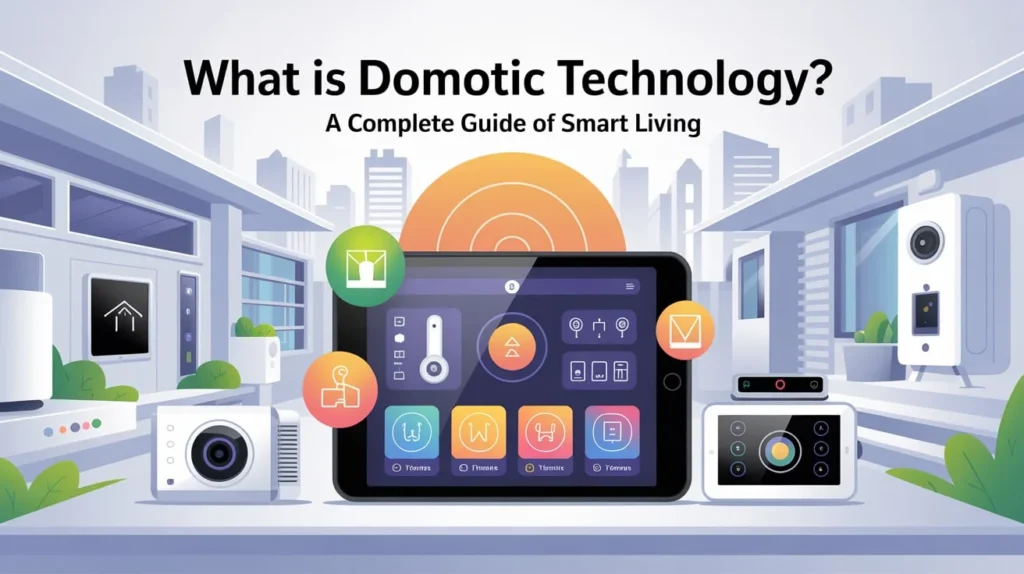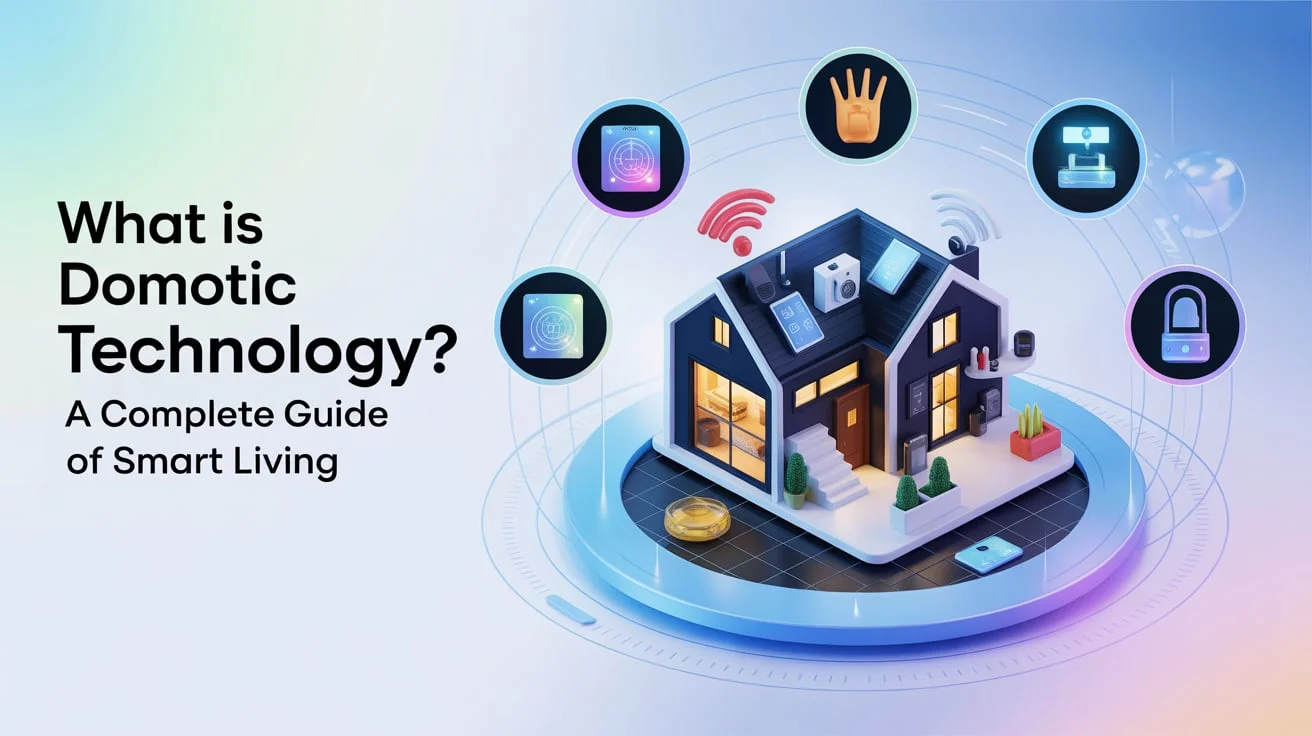Domotic technology refers to the integration of intelligent systems within a household to manage and automate tasks. These systems allow you to control lighting, temperature, appliances, security, and more through digital interfaces or voice commands. It’s the brain behind a truly “smart” home.
The word “domotic” originates from the Latin word domus, meaning home, combined with “robotic” or “automatic.” This combination represents an advanced system where technology and convenience coexist seamlessly to enhance daily living.
This innovation has quickly evolved beyond luxury; it’s now a mainstream lifestyle upgrade. With more people working remotely and looking for comfort, domotic technology is becoming essential for energy efficiency, time management, and overall household security.
Key Components of Domotic Technology
To understand the value of domotic technology, we must examine its core components. These systems work in harmony to simplify and optimize your living experience. From voice-controlled devices to app-integrated hubs, each part contributes to creating an efficient home environment.
Below are two primary components that define the strength of domotic systems:
1. Smart Sensors and Devices
These are the eyes and ears of your smart home. Sensors can detect movement, light levels, temperature, and even air quality. Paired with smart devices, they help in automating routine tasks, like turning on lights when you enter a room or adjusting thermostats according to room occupancy.
2. Centralized Control Systems
This is often a smartphone app or voice assistant like Alexa, Google Assistant, or Siri. These centralized systems allow users to control multiple devices with ease. Integration ensures smooth operation and complete control over your home, even remotely.
Benefits of Domotic Technology in Daily Life

Domotic systems improve quality of life and contribute to sustainability and security. Imagine controlling all your appliances with a single tap. It’s not a luxury anymore, it’s smart living. Domotic technology is helping homeowners achieve that dream with reliability and innovation.
Here are some key advantages:
- Energy savings by regulating the usage of lights and appliances
- Enhanced home security with smart cameras and alarm systems
- Increased convenience through automation and remote access
- Better home management via data analytics and real-time updates
- Integration with green energy systems like solar panels
Common Applications of Domestic Technology
Let’s explore where domotic technology shines the most. While it covers a wide range of uses, some applications stand out due to their practicality and demand.
Home Security and Surveillance
Modern smart homes are equipped with cameras, motion sensors, and smart locks that can be accessed through mobile apps. These systems notify homeowners in real-time, improving safety and response time in case of emergencies.
Smart Lighting and Climate Control
These features adapt based on your habits. Motion detectors can turn lights on or off, and smart thermostats can learn your temperature preferences. This helps reduce energy waste and enhances comfort.
Top Features That Make Smart Homes Smarter
When selecting or upgrading a home automation system, knowing what features matter the most is essential. While the tech is advanced, it’s the user experience that drives value. Here are some crucial features:
- Voice recognition and command integration
- Remote access and mobile control
- Scheduled automation for daily tasks
- Real-time data monitoring and analytics
- Compatibility with third-party platforms
These features ensure that domotic systems are easy to use and adapt to the lifestyle of modern users.
Future Trends in Domestic Technology
The future of domotic technology looks incredibly promising. With AI and machine learning, homes are becoming more intuitive.
These systems can now understand user behavior and make predictions to optimize comfort and efficiency.
Voice control is also getting smarter, offering multilingual and contextual understanding. Furthermore, integration with renewable energy solutions is making homes greener.
As 5G technology expands, faster and more reliable connections will push domotics even further into mainstream society.
How to Get Started with Domotic Technology
Many homeowners are curious about transitioning into smart living but feel overwhelmed. The good news is that starting small can still make a significant impact. You don’t have to automate everything at once. Begin with one or two areas of your home.
Steps to begin with domotic systems:
- Identify areas in your home that need automation
- Start with basic devices like bright lights or a plug.
- Choose a centralized platform for control (e.g., Google Home)
- Make sure your Wi-Fi network is secure and reliable.
- Gradually expand your system over time.
Remember, the goal is not just to make your home smart; it is also to make it smarter for you.
Challenges and Solutions in Domestic Systems
Despite their advantages, domotic systems face certain limitations. These include high initial costs, compatibility issues, and privacy concerns. However, the industry is addressing these challenges through innovation and user-friendly interfaces.
High costs are declining as demand increases, and many companies are working towards cross-platform compatibility. As for privacy, modern systems now come with end-to-end encryption and data protection policies.
Conclusion:
Domotic technology is more than just a trend; it’s a transformational force in the way we live. From saving energy to boosting home security and offering unmatched convenience, it’s redefining modern living standards.
If you’re looking to future-proof your home and improve your daily life, now is the time to invest in innovative technology. Start with what you need, explore what’s possible, and embrace the comfort and control that domotic technology offers.
Frequently Asked Questions:
Q1. Is domotic technology suitable for all types of homes?
Yes, both new constructions and older homes can benefit from innovative systems with the proper setup.
Q2. Can domotic systems save electricity?
Absolutely. Automated lights, thermostats, and appliance controls significantly reduce energy waste.
Q3. Are domotic systems hard to install?
Many smart devices are plug-and-play, and professional installation is optional for more complex setups.
Q4. What’s the average cost to install a domotic system?
Costs vary depending on the setup. A basic system may start at $200, while advanced ones can cost more than $2000.




